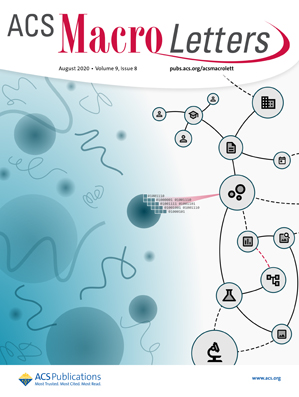Wrapping of Nano- and Microgels by Lipid-Bilayer Membranes.
IF 5.2
Q1 POLYMER SCIENCE
引用次数: 0
Abstract
The wrapping of nano- and microparticles is a fundamentally important pathway for their cellular uptake and depends on the physicochemical properties of both particle and membrane. Polymeric gels are a versatile class of materials whose elastic properties can be tuned in a wide range from ultrasoft to hard by changing the density of cross-linkers. Using spring networks for the microgels and triangulated surfaces for the membranes, we study microgel wrapping with computer simulations. The interplay of microgel and membrane deformation is controlled by the competition between microgel elasticity and membrane bending rigidity. Compared with hard particles, the range of adhesion strengths for which partial-wrapped states are stable is enlarged. Volume and surface area of partial-wrapped microgels can be significantly reduced compared with those of free microgels. Understanding microgel wrapping can help us to design polymeric particles for biomedical applications, e.g., as membrane markers and targeted drug delivery vectors.脂质双层膜包裹纳米和微凝胶。
纳米粒子和微粒子的包裹是细胞摄取的重要途径,这取决于粒子和膜的物理化学性质。聚合物凝胶是一种用途广泛的材料,它的弹性性能可以通过改变交联剂的密度来调整,从超软到硬的范围很广。用弹簧网作为微凝胶的表面,用三角表面作为膜的表面,我们用计算机模拟研究了微凝胶的包裹。微凝胶与膜变形的相互作用受微凝胶弹性与膜弯曲刚度的竞争控制。与硬颗粒相比,部分包裹状态稳定的粘附强度范围扩大。与游离微凝胶相比,部分包裹微凝胶的体积和表面积明显减小。了解微凝胶包裹可以帮助我们设计用于生物医学应用的聚合物颗粒,例如作为膜标记物和靶向药物传递载体。
本文章由计算机程序翻译,如有差异,请以英文原文为准。
求助全文
约1分钟内获得全文
求助全文
来源期刊
CiteScore
10.40
自引率
3.40%
发文量
209
审稿时长
1 months
期刊介绍:
ACS Macro Letters publishes research in all areas of contemporary soft matter science in which macromolecules play a key role, including nanotechnology, self-assembly, supramolecular chemistry, biomaterials, energy generation and storage, and renewable/sustainable materials. Submissions to ACS Macro Letters should justify clearly the rapid disclosure of the key elements of the study. The scope of the journal includes high-impact research of broad interest in all areas of polymer science and engineering, including cross-disciplinary research that interfaces with polymer science.
With the launch of ACS Macro Letters, all Communications that were formerly published in Macromolecules and Biomacromolecules will be published as Letters in ACS Macro Letters.

 求助内容:
求助内容: 应助结果提醒方式:
应助结果提醒方式:


